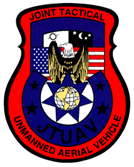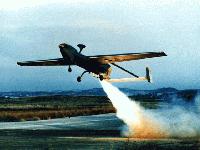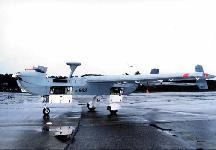




 Hunter is an Israeli multi-role short-range UAV system in service with the U.S. Army (manufactured & marketed jointly with TRW/S&ITG). One system has been sold to the French Army, and it has been selected for service by the Belgium Army. Hunter has supported Army and Joint operations and training, and payload testing since Feb 96. Some of the payloads tested on Hunter were a laser designator, VHF/UHF radio relay and several payloads for the Joint Command and Control Warfare Center.
Hunter is an Israeli multi-role short-range UAV system in service with the U.S. Army (manufactured & marketed jointly with TRW/S&ITG). One system has been sold to the French Army, and it has been selected for service by the Belgium Army. Hunter has supported Army and Joint operations and training, and payload testing since Feb 96. Some of the payloads tested on Hunter were a laser designator, VHF/UHF radio relay and several payloads for the Joint Command and Control Warfare Center.
The US Department of Defense Joint Project Office's first UAV acquisition effort was the Short Range UAV, subsequently named the Hunter. The program was started in 1988. It was originally estimated to cost about $1.2 billion for development and procurement of 50 systems with 400 Hunter air vehicles and other associated equipment. However, by the end of the program in 1995, the cost was expected to be $2.1 billion for development and procurement of 52 systems. Hunter, was cancelled in January 1996 after some 20 air vehicle crashes, with only seven of the planned 50 production systems delivered.
The Hunter Joint Tactical UAV was originally developed to provide both ground and maritime forces with near-real-time IMINT within 200 km direct radius of action, extensible to 300+ km by using another Hunter as an airborne relay. The mission of the Hunter was to be day and night reconnaissance, intelligence, surveillance, and target acquisition for Corps Commanders. It was to be deployed to Army divisions and corps, as well as naval task forces. Because of line-of-sight limits, the system's range and ability to see over terrain were dependent on the use of a second Hunter air vehicle operating at a closer range to relay imagery from the first air vehicle to the task force or ground commander.
During Limited User Testing in 1992, Hunter's demonstrated problems included the inability to reliably transmit video imagery during relay operations, meet Army time standards for artillery adjustments, and meet standards for reliability. Hunter successfully completed only 4 of 11 relay flights. Test results revealed (1) the system's ability to transmit video imagery during relay operations was unacceptable for a fielded system, (2) the system may never meet Army time standards for artillery adjustments, and (3) the system was unreliable. The Hunter system, with all its associated parts and support vehicles, was also far too large to fit in the number of airlift aircraft specified for moving one system.
Nevertheless, the DAB approved a low-rate production decision for Hunter and a contract a $171 million low-rate initial production (LRIP) contract for seven Hunter systems was awarded to Israel Aircraft Industries/TRW in January 1993. Navy requirements were validated by the Joint Requirements Oversight Council in May 1993. Subsequent logistics demonstrations in 1993 revealed that the system could not be supported in the field.
The Hunter contractor began delivering the seven LRIP systems in May 1994. Government acceptance testing of these systems revealed new deficiencies with the system's software, data link and engines. Observations on reasons for problems: DOD did not allow enough time to perform (1) system integration necessary to integrate non-developmental components of the system or (2) analyses necessary to develop a logistic support system. Several crashes occurring in short order led to the system being grounded for months. A Navy Program Decision Memorandum in November 1994 authorized proceeding with the Hunter/Shipboard program. The Navy Program Decision Memorandum directed that 18 of the Hunter full-rate production systems be adapted for deployment on amphibious assault ships and aircraft carriers (LHA/LHD/CV/CVN class ships).
The first Hunter LRIP system was accepted April 14, 1995, almost one year after the originally scheduled date. Five systems were accepted by September 1995. In October 1995, the Joint Requirements Oversight Council strongly recommended termination of the Hunter Program. On January 31, 1996, the Defense Acquisition Executive announced his decision not to procure additional Hunter systems beyond the low-rate production and to allow the current contract to expire.
| Manufacturer: TRW |
Runway (ISA): assault: 2000 ft. x 100 |
RATO: yes |
Dimensions: length-271.6 in. span-350.3 in. height- 66.8 in. |
| System Composition
|
Data Link: Frequency: C-band Band width 20 Mhz Data Rate 7.317 kbps Line of Sight: yes Satellite: no GPS:yes |
Range: 125 km on GCS 50 km on LRS 75 km on ADR |
Power Plant: 2 x Moto Guzzi 750 cc pusher/puller |
| Fuel: type- 87 mogas capacity- 190 liters |
Endurance: 8 - 10 hours |
Payloads: CCD (daylight only) FLIR (day-night) modular |
Operational Altitudes (ISA): to 16,000 ft. MSL |
| Speeds: stall- 53 kts cruise- 70 kts dash-110 kts |
Weights Empty 1200 lbs Fuel Weight 300 lbs Payload 200 lbs Max Takeoff 1600 lbs |
Weather limits: T/O cross winds-15 kts T/O head winds- 25 kts rain-limited visible moisture-limited icing-no turbulence-light |
Auto. Return Home on Data Link Loss: yes |
| Emergency Recovery: parachute |
Relay Flight Capability: yes |
Multiple AV Control: yes: relay flight/ autonomous flight |
Control Transfer to Another Shelter: yes |



